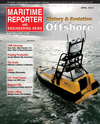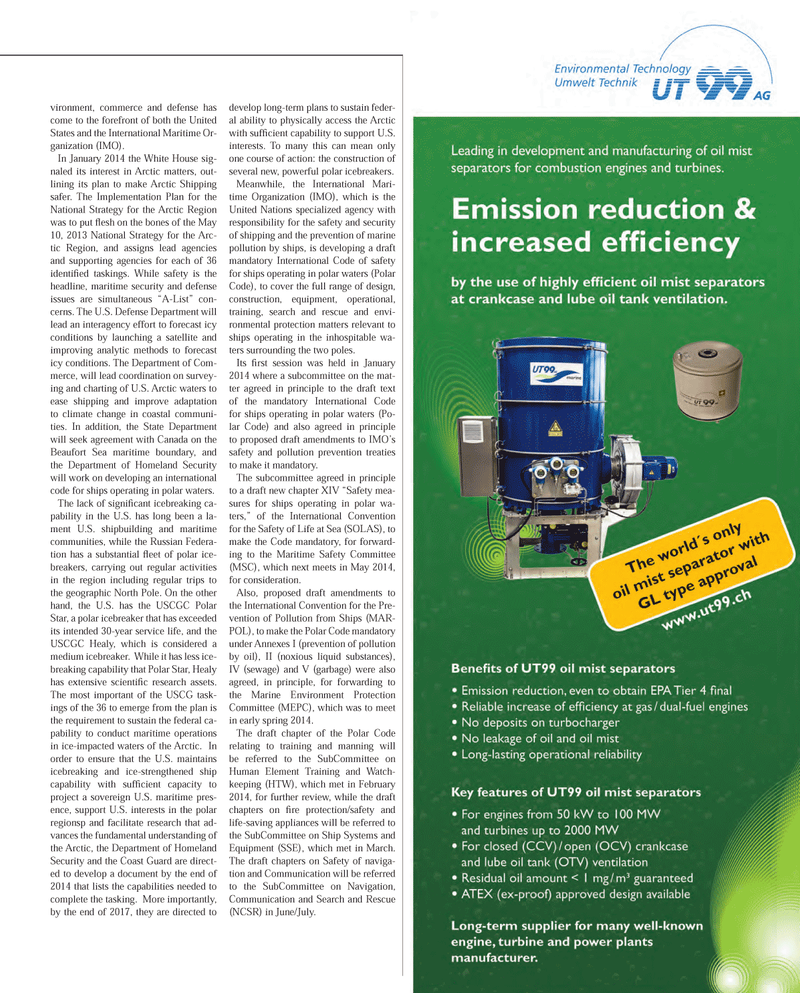
Page 49: of Maritime Reporter Magazine (April 2014)
Offshore Edition
Read this page in Pdf, Flash or Html5 edition of April 2014 Maritime Reporter Magazine
vironment, commerce and defense has come to the forefront of both the United States and the International Maritime Or- ganization (IMO).In January 2014 the White House sig- naled its interest in Arctic matters, out- lining its plan to make Arctic Shipping safer. The Implementation Plan for the National Strategy for the Arctic Region was to put ß esh on the bones of the May 10, 2013 National Strategy for the Arc- tic Region, and assigns lead agencies and supporting agencies for each of 36 identiÞ ed taskings. While safety is the headline, maritime security and defense issues are simultaneous ?A-List? con-cerns. The U.S. Defense Department will lead an interagency effort to forecast icy conditions by launching a satellite and improving analytic methods to forecast icy conditions. The Department of Com- merce, will lead coordination on survey-ing and charting of U.S. Arctic waters to ease shipping and improve adaptation to climate change in coastal communi-ties. In addition, the State Department will seek agreement with Canada on the Beaufort Sea maritime boundary, and the Department of Homeland Security will work on developing an international code for ships operating in polar waters.The lack of signiÞ cant icebreaking ca- pability in the U.S. has long been a la-ment U.S. shipbuilding and maritime communities, while the Russian Federa-tion has a substantial ß eet of polar ice- breakers, carrying out regular activities in the region including regular trips to the geographic North Pole. On the other hand, the U.S. has the USCGC Polar Star, a polar icebreaker that has exceeded its intended 30-year service life, and the USCGC Healy, which is considered a medium icebreaker. While it has less ice- breaking capability that Polar Star, Healy has extensive scientiÞ c research assets. The most important of the USCG task-ings of the 36 to emerge from the plan is the requirement to sustain the federal ca-pability to conduct maritime operations in ice-impacted waters of the Arctic. In order to ensure that the U.S. maintains icebreaking and ice-strengthened ship capability with sufÞ cient capacity to project a sovereign U.S. maritime pres-ence, support U.S. interests in the polar regionsp and facilitate research that ad-vances the fundamental understanding of the Arctic, the Department of Homeland Security and the Coast Guard are direct-ed to develop a document by the end of 2014 that lists the capabilities needed to complete the tasking. More importantly, by the end of 2017, they are directed to develop long-term plans to sustain feder- al ability to physically access the Arctic with sufÞ cient capability to support U.S. interests. To many this can mean only one course of action: the construction of several new, powerful polar icebreakers. Meanwhile, the International Mari-time Organization (IMO), which is the United Nations specialized agency with responsibility for the safety and security of shipping and the prevention of marine pollution by ships, is developing a draft mandatory International Code of safety for ships operating in polar waters (Polar Code), to cover the full range of design, construction, equipment, operational, training, search and rescue and envi-ronmental protection matters relevant to ships operating in the inhospitable wa-ters surrounding the two poles.Its Þ rst session was held in January 2014 where a subcommittee on the mat-ter agreed in principle to the draft text of the mandatory International Code for ships operating in polar waters (Po-lar Code) and also agreed in principle to proposed draft amendments to IMO?s safety and pollution prevention treaties to make it mandatory. The subcommittee agreed in principle to a draft new chapter XIV ?Safety mea- sures for ships operating in polar wa-ters,? of the International Convention for the Safety of Life at Sea (SOLAS), to make the Code mandatory, for forward- ing to the Maritime Safety Committee (MSC), which next meets in May 2014, for consideration.Also, proposed draft amendments to the International Convention for the Pre-vention of Pollution from Ships (MAR-POL), to make the Polar Code mandatory under Annexes I (prevention of pollution by oil), II (noxious liquid substances), IV (sewage) and V (garbage) were also agreed, in principle, for forwarding to the Marine Environment Protection Committee (MEPC), which was to meet in early spring 2014.The draft chapter of the Polar Code relating to training and manning will be referred to the SubCommittee on Human Element Training and Watch- keeping (HTW), which met in February 2014, for further review, while the draft chapters on Þ re protection/safety and life-saving appliances will be referred to the SubCommittee on Ship Systems and Equipment (SSE), which met in March. The draft chapters on Safety of naviga-tion and Communication will be referred to the SubCommittee on Navigation, Communication and Search and Rescue (NCSR) in June/July. MR #4 (42-49).indd 49MR #4 (42-49).indd 494/7/2014 8:12:37 PM4/7/2014 8:12:37 PM

 48
48

 50
50
